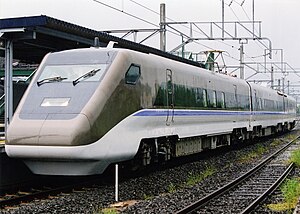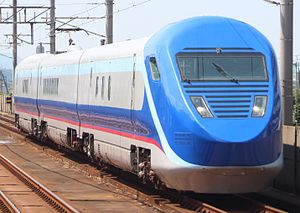Gauge Change Train
| Gauge Change Train | |
|---|---|

First-generation train on the Yosan Line, May 2003
|
|
| Manufacturer | Kawasaki Heavy Industries, Kinki Sharyo, Tokyu Car Corporation |
| Constructed | 1998 |
| Number built | 3 vehicles |
| Number preserved | 1 vehicle |
| Number scrapped | 2 vehicles |
| Formation | 3-car set |
| Specifications | |
| Car length | 23,075 mm (75 ft 8.5 in) (end cars) 20,500 mm (67 ft 3 in) (intermediate car) |
| Width | 2,945 mm (9 ft 7.9 in) |
| Maximum speed | 300 km/h (185 mph) (shinkansen lines) 130 km/h (80 mph) (narrow gauge lines) |
| Traction system | RMT17 traction motors (x2 per axle) |
| Power output | 190 kW (250 hp) per axle (25 kV AC) |
| Electric system(s) | 25 kV AC (50/60), 20 kV AC (50/60), 1,500 V DC, Overhead wire |
| Current collection method | Pantograph |
| Track gauge | 1,067 mm (3 ft 6 in) – 1,435 mm (4 ft 8 1⁄2 in) |
| Gauge Change Train | |
|---|---|

The second-generation set undergoing testing on the Yosan Line in Shikoku, September 2012
|
|
| Constructed | 2006 |
| Scrapped | 2014 |
| Number built | 3 vehicles |
| Number preserved | 1 vehicle |
| Number scrapped | 2 vehicles |
| Formation | 3-car set |
| Capacity | 36 |
| Specifications | |
| Car length | 23,075 mm (75 ft 8.5 in) (end cars) 20,500 mm (67 ft 3 in) (intermediate car) |
| Width | 2,945 mm (9 ft 7.9 in) |
| Height | 4,030 mm (13 ft 3 in) |
| Maximum speed | 270 km/h (170 mph) (shinkansen lines) 130 km/h (80 mph) (narrow gauge lines) |
| Axle load | max 12.5 t (12.3 long tons; 13.8 short tons) |
| Electric system(s) | 25 kV AC (60 Hz), 20 kV AC (60 Hz), 1,500 V DC, Overhead wire |
| Current collection method | Pantograph |
| Track gauge | 1,067 mm (3 ft 6 in) – 1,435 mm (4 ft 8 1⁄2 in) |
| Gauge Change Train | |
|---|---|

The third-generation train, FGT-9000, on test in November 2014
|
|
| Constructed | 2014 |
| Number built | 4 vehicles |
| Formation | 4-car set |
| Specifications | |
| Car length | 23,075 mm (75 ft 8.5 in) (end cars) 20,500 mm (67 ft 3 in) (intermediate cars) |
| Width | 2,945 mm (9 ft 7.9 in) |
| Height | 3,650 mm (12 ft 0 in) |
| Maximum speed | 270 km/h (170 mph) (shinkansen lines) 130 km/h (80 mph) (narrow gauge lines) |
| Electric system(s) | 25 kV AC (60 Hz), 20 kV AC (60 Hz), 1,500 V DC, Overhead wire |
| Current collection method | Pantograph |
| Track gauge | 1,067 mm (3 ft 6 in) – 1,435 mm (4 ft 8 1⁄2 in) |
The Gauge Change Train (GCT) or Free Gauge Train (フリーゲージトレイン?, "FGT") is the name given to a Japanese project started in 1994 to develop a high-speed train with variable gauge axles to allow inter-running between the 1,435 mm (4 ft 8 1⁄2 in) standard gauge Shinkansen network, and the 1,067 mm (3 ft 6 in) narrow gauge regional rail network.
Two three-car and one four-car "GCT" electric multiple unit (EMU) trains have been built for testing. The first train operated from 1998 until 2006, the second train operated from 2006 until 2014 and the third-generation train commenced testing in 2014, although testing is currently suspended due to technical issues with the bogies. The GCT was due to be introduced on the West Kyushu Shinkansen upon its scheduled opening in fiscal 2022, and whilst the line opening remains on schedule, introduction of the GCT is now scheduled for fiscal 2025 at the earliest.
The first GCT train was completed in October 1998. It was designed to be able to run at a maximum speed of over 300 km/h (185 mph) on Shinkansen lines, and at over 130 km/h (80 mph) on conventional narrow-gauge lines under a catenary voltage of 25 kV AC (50/60 Hz), 20 kV AC (50/60 Hz), or 1,500 V DC.
The train was formed as shown below, with all three cars motored.
Car 1 was built by Kawasaki Heavy Industries, car 2 was built by Kinki Sharyo, and car 3 was built by Tokyu Car Corporation.
...
Wikipedia
